Preparing for Adoption
Before adopting a new cat/kitten(s) we strongly recommend you take the time to do some research and make an educated decision about which cat/Kitten is the right fit for your household.
Below are some key points to consider.
Below are some key points to consider.
- Adopting a cat/kitten(s) from a rescue is very different then adopting from an online posting, a friend, or even a pet shop. The main benefit to adopting from a rescue is that you get a guarantee of health for a much smaller fee then it would cost at your local veterinarian. Tender Loving Cats, Inc. (TLC) cat/kitten(s) have all been seen by a vet, tested negative for feline leukemia virus (FeLV), they will have had vaccinations, been microchipped and spayed/neutered, and if there are any major health issues like dental work needed or eye surgeries, hernia repair, etc. they’ll have that done before they’re re-homed. If there’s ongoing medical conditions you are made aware of those issues and can make an educated decision. Rescues have made behavioral assessments of each cat/kitten and can help you determine what cat/kitten is the right temperament for your family.
- The minimal adoption fee donation you pay to a rescue is no where close to the amount that would be paid for those services at a local veterinarian. Tender Loving Cats, Inc. pays an average of $180-$200 for the medical care provided to our rescue cat/kitten(s) but these services would cost upwards of $400 plus at a local vet. We only collect and adoption fee of $150/kitten, $100/adult cat and $75/special needs or senior cat 7+ yrs. We can only afford this by fundraising throughout the year.
- Take the time to meet some of the shy cat/kitten(s) - these cat/kitten(s) typically need to feel safe with you and once they do they will be one of your most loyal friends. Don’t dismiss some of the harder to place cat/kitten(s) like all black or black and white cat/kitten(s) - these kitties are some of the sweetest cat/kitten(s) you’ll ever meet.
- You should be prepared to provide enrichment such as various different types of scratching posts, shelves, puzzle feeders, interactive wand toys. You should give your adopted cat/kitten interactive play at least 10 minutes twice a day if possible. We recommend wand toys such as Go Cat Teaser Cat Catcher Wand Cat Toy, Interactive Retractable Wand Rod with Assorted Feather Toy, and Jackson Galaxy's Ground Prey Cat Wand.
- Two is always better then one! Kittens under a year old do best in a home with another young cat or kitten. We are not trying to up sell you on adopting two kittens but you should know why we recommend adopting two kittens. (See#6)
- Many well respected and reputable rescues, including ours, will require that kittens under 12wks of age not go home alone without another adequate feline companion. Although, not every person has experienced “Single Kitten Syndrome” aka “Tarzan Syndrome” it’s important that adopters understand that it is very likely to happen if you choose to adopt a kitten under 12wks and they do not have a feline companion.
After many years of working in the veterinary field and learning about feline behavior our President & Founder has determined that single kittens under 12wks of age, adopted out without an adequate feline companion can become aggressive, bitey and often lack confidence that leads to inappropriately urination as they get older. It’s important that each kittens behavior be accessed individually as some kittens, even if remain with siblings until 12wkd, will do better with another kitten or young adult cat but as a general rule Tender Loving Cats, Inc. does not adopt out kittens under 12wk of age to be alone in a household with no other age appropriate feline companions. The critical learning age for a kitten is between 8-12wks. If anyone has ever watched 2 kittens wrestle and cry out in pain or frustration you know that this wrestling can be quite aggressive. During this critical age range a human cannot teach a kitten that biting hurts by biting back or essentially how to be a "cat”! When kittens don’t have other kittens to learn from during this critical time what happens to them is something called “Single Kitten Syndrome” or “Tarzan Syndrome” and it’s very very real. According to the data we have collected over the last 15 years in rescue - we’ve found that 90% of all kittens adopted out under the age of 3mths without another age appropriate feline playmate get returned or abandoned once they are adults. Sadly, at that point it’s quite difficult to change this behavior. These cats are typically unable to be integrated with other cats as they don’t understand how to interact with them, they nip and can become aggressive without warning and often are euthanized in shelters or end up in barn placement.
Here are some resources if you're interested in learning more about the subject of “Single Kitten Syndrome” or “Tarzan Syndrome”.
http://www.meowcatrescue.org/resources/articles/12/single-kitten-syndrome/index.html
www.adoptapet.com/blog/how-to-cure-only-kitten-syndrome/
https://iaabc.org/cat/tarzan-syndrome
https://thecatsite.com/threads/single-kitten-syndrome-orphan.314283/ - What happens if a resident pet doesn’t get along with your new kitty? Although we always take our cats & kittens back, you want to make every effort for that not to happen. It’s important to go into this process by letting go of the dream that your cat or dog will absolutely fall in-love with another kitty and you should be happy with peaceful coexistence. That being said, slow & steady wins the race when it comes to introducing. Some pets get along within a few days of meeting and some don’t, it is much better to go slow and not ruin the relationship then try to push it too soon and never be able to go backwards. After following Jackson Galaxy’s instructions below on “cat-to-cat introductions” (this method can be used to introduce to dogs as well) when it comes time for them to meet face to face we additionally suggest placing a dog crate or pop-up playpen in a main living space for the new kitty to spend a few hours a day acclimating into a main living area so that your resident pet can get used to them “being around” without being in their face.
To Cat or To Kitten?
That Is The Question.
How to Choose the Right Cat/Kitten(s)
Tips for Adopting a Rescue Cat/Kitten(s)
CAT-TO-CAT INTRODUCTIONS
By Jackson Galaxy
The common wisdom in introducing a newly adopted cat to a resident one in the past was to open the carrying case and “let them work it out.” We most definitely have a new way of looking at things; from the cat’s perspective. Cats are, after all, about territory. Bring a new, utterly alien scent of the same species into the house, and more times than not, we’re asking for chaos. Of course everyone has a story about introducing two cats that went smoothly doing the old fashioned technique. The point to stress is, if it goes poorly, this one meeting is the association that these two cats will hold onto for quite a long time and make a peaceable kingdom a difficult task. It is, ultimately, better to be safe than sorry.
It is crucial to recognize that it’s the cats who dictate the pace. With some, things go smoothly from the start, and they’re ready to be best pals in a matter of days. However, it is much more likely to take longer–weeks to months! We cannot emphasize this too much: it’s not up to you to decide how long each step should take! The cats themselves will signal when they’re ready to go to the next step. If you too fast, you will jeopardize the whole process.
A slow and steady introduction starts with the establishment of a base camp for the newcomer. Once you’ve set up his or her space, you’re ready to start letting the cats make positive associations between one another. This is key, and will be repeated ad infinitum; all associations between the cats during this critical period have to be as pleasing as possible to reduce possible friction when they finally have free access.
Let’s start with one of the most pleasing motivators—food! Feeding time will happen at the door of base camp until introduction is complete. If the resident cat is not on a scheduled feeding diet, it might be best to put him or her on one for now. Or, if you leave dry food out and supplement with wet food, greatly decrease the amount of dry so that wet feeding time is looked forward to more. Remember that the only time either cat gets wet food is during these “meet and greets” at the base camp door, which can be divided into two daily sessions. Place food bowls on either side of the door with a couple of feet of breathing room for each cat. Ideally, there should be a family member on either side of the door to praise each cat as they eat. The idea is that they are rewarded with food for being so close to the scent of the unfamiliar cat, and also rewarded by you with praise for eating. At this initial point, the door should be closed; the cats can smell one another just fine. If they don’t devour their food at first, that’s okay. They will eventually eat. Don’t give in and move the food.
The next step is to open the door just a tiny crack, giving the cats limited visual access to each other. How soon do you move on to this step? As with all steps in introduction, pay attention to the cats; let their body language tell you when they are comfortable enough to move on. Remember that proceeding too quickly will force you to jump backwards by anywhere from a few days to a few weeks. Slow and steady definitely wins this race. We need to remain safe, so use rubber doorstops on either side of the introduction door to prevent any more than visual accessibility. If the door is too high off the ground to use stops, or if one or both cats are muscling the door open, try using a hook and eye setup. Instead of using it to lock a door shut, you would employ it backwards, to give us just a couple of inches of cracked space between the door and the jamb.
Again, the time required in moving from step to step is determined by your observation and the cats’ level of comfort. Keep cracking the door further until each cat could, if they wished, bat at one another—first up to the elbow joint then all the way to the shoulder, just making sure not to leave enough room to let a head get through. The object of “the game” is to give them enough rope to succeed. If they fail, just go back to the previous step.
Other tricks to use during the introduction period are “scent swapping” and “site swapping.” In scent swapping, we take a washcloth per cat and rub them down with it, making sure to go across their cheeks, head, sides, and around the base of the tail. Then, present the other cat with the scent of the washcloth in a conspicuous part of their territory, perhaps near a favored sleeping spot or near (but respecting the space of) their food or water. This will start getting them accustomed to the new facts of life; their space will have to be shared with one another, and better to have this fact introduced by scent than sight.
Site swapping relies on more paws-on physical exploration of one another’s space. Once a day, switch the two cats. The new cat gets to explore the house while the resident cat is base camp to freely explore the scent of new arrival without the fear of retribution. This process is best done with a human partner just to make sure the cats don’t inadvertently get in each other’s way while trading places; but if you don’t have help, try putting the resident in, say, a bedroom. When the new cat heads for the kitchen or other area out of sight, move the resident cat into base camp. Both cats should get the praise and encouragement they need/deserve in bravely going where they have not gone before!
Don’t forget, during this entire process, to play with the cats! This may seem elementary, but remember, they are just energetic balloons naturally, and even more so during these intense times of stress. Of course, you will have separate play sessions during the introduction phase. Once they’ve met and cohabitated for a bit, group playtime will be another wonderful way of diverting aggression they might have towards one another into a positive route. Refer to our article on play therapy to learn the ins and outs of keeping them both as happy as possible during the period of adjustment.
Additionally, consider flower essences to help both (or all) cats get through the initial introduction period with the least amount of stress and anxiety. Spirit Essences has many formulas to choose from, depending on the personalities involved, including “Peacemaker” and “New Beginnings.”
When you think it’s time to let them be in the territory together at the same time, take precautions. If a fight breaks out, do not try to break it up with your hands! Unfortunately, this is most of the time our first instinct. You are almost sure to be clawed and bitten, and it will not be pretty. In the heat of the moment, the cats will not be able to distinguish between your arm and each other, and they will have no inhibition about attacking whatever is handy, even if it’s you. Instead, have an immediate barrier like a couple of large, thick towels or blankets at the ready. You can toss them over the cats to disorient them, and immediately relocate them by scooping them up inside the towel (to protect yourself). There is no need to follow this up with a scolding. That will not do anything except increase the cats’ agitation, which is just what you don’t need! Let the event pass with each cat in their own “time-out”, and start again fresh tomorrow—at the very beginning. Also make sure that when the two cats meet, they have escape routes from one another. Getting cornered is a sure recipe for a fight in the mind of a defense-minded animal like a cat.
Keep a close eye on all interactions for the first week or so, not letting the cats have free access to one another when nobody is home. Finally, keep the food and litter setup established in the base camp room, at least for the next while. The accepted “recipe” is three litterboxes for two cats (to be precise, 1 box per cat + 1), so bear that in mind. Also bear in mind escape routes from the boxes, as the last place we want a skirmish to erupt is while one of the cats is having a “private moment.” They should be able to see as much of the room around them as possible when in the litterbox, which is why uncovered boxes would be highly recommended.
This should pretty well cover the bases for the initial introduction between your cats. Of course there are always variables, but the broken record theme should get you going; do it slow—there’s always tomorrow to make another positive impression. They can, over time, learn that every time they view or smell the other, something good will happen. Do it too quickly and that negative first impression might very well be the one that lasts.
http://www.littlebigcat.com/behavior/cat-to-cat-introductions
It is crucial to recognize that it’s the cats who dictate the pace. With some, things go smoothly from the start, and they’re ready to be best pals in a matter of days. However, it is much more likely to take longer–weeks to months! We cannot emphasize this too much: it’s not up to you to decide how long each step should take! The cats themselves will signal when they’re ready to go to the next step. If you too fast, you will jeopardize the whole process.
A slow and steady introduction starts with the establishment of a base camp for the newcomer. Once you’ve set up his or her space, you’re ready to start letting the cats make positive associations between one another. This is key, and will be repeated ad infinitum; all associations between the cats during this critical period have to be as pleasing as possible to reduce possible friction when they finally have free access.
Let’s start with one of the most pleasing motivators—food! Feeding time will happen at the door of base camp until introduction is complete. If the resident cat is not on a scheduled feeding diet, it might be best to put him or her on one for now. Or, if you leave dry food out and supplement with wet food, greatly decrease the amount of dry so that wet feeding time is looked forward to more. Remember that the only time either cat gets wet food is during these “meet and greets” at the base camp door, which can be divided into two daily sessions. Place food bowls on either side of the door with a couple of feet of breathing room for each cat. Ideally, there should be a family member on either side of the door to praise each cat as they eat. The idea is that they are rewarded with food for being so close to the scent of the unfamiliar cat, and also rewarded by you with praise for eating. At this initial point, the door should be closed; the cats can smell one another just fine. If they don’t devour their food at first, that’s okay. They will eventually eat. Don’t give in and move the food.
The next step is to open the door just a tiny crack, giving the cats limited visual access to each other. How soon do you move on to this step? As with all steps in introduction, pay attention to the cats; let their body language tell you when they are comfortable enough to move on. Remember that proceeding too quickly will force you to jump backwards by anywhere from a few days to a few weeks. Slow and steady definitely wins this race. We need to remain safe, so use rubber doorstops on either side of the introduction door to prevent any more than visual accessibility. If the door is too high off the ground to use stops, or if one or both cats are muscling the door open, try using a hook and eye setup. Instead of using it to lock a door shut, you would employ it backwards, to give us just a couple of inches of cracked space between the door and the jamb.
Again, the time required in moving from step to step is determined by your observation and the cats’ level of comfort. Keep cracking the door further until each cat could, if they wished, bat at one another—first up to the elbow joint then all the way to the shoulder, just making sure not to leave enough room to let a head get through. The object of “the game” is to give them enough rope to succeed. If they fail, just go back to the previous step.
Other tricks to use during the introduction period are “scent swapping” and “site swapping.” In scent swapping, we take a washcloth per cat and rub them down with it, making sure to go across their cheeks, head, sides, and around the base of the tail. Then, present the other cat with the scent of the washcloth in a conspicuous part of their territory, perhaps near a favored sleeping spot or near (but respecting the space of) their food or water. This will start getting them accustomed to the new facts of life; their space will have to be shared with one another, and better to have this fact introduced by scent than sight.
Site swapping relies on more paws-on physical exploration of one another’s space. Once a day, switch the two cats. The new cat gets to explore the house while the resident cat is base camp to freely explore the scent of new arrival without the fear of retribution. This process is best done with a human partner just to make sure the cats don’t inadvertently get in each other’s way while trading places; but if you don’t have help, try putting the resident in, say, a bedroom. When the new cat heads for the kitchen or other area out of sight, move the resident cat into base camp. Both cats should get the praise and encouragement they need/deserve in bravely going where they have not gone before!
Don’t forget, during this entire process, to play with the cats! This may seem elementary, but remember, they are just energetic balloons naturally, and even more so during these intense times of stress. Of course, you will have separate play sessions during the introduction phase. Once they’ve met and cohabitated for a bit, group playtime will be another wonderful way of diverting aggression they might have towards one another into a positive route. Refer to our article on play therapy to learn the ins and outs of keeping them both as happy as possible during the period of adjustment.
Additionally, consider flower essences to help both (or all) cats get through the initial introduction period with the least amount of stress and anxiety. Spirit Essences has many formulas to choose from, depending on the personalities involved, including “Peacemaker” and “New Beginnings.”
When you think it’s time to let them be in the territory together at the same time, take precautions. If a fight breaks out, do not try to break it up with your hands! Unfortunately, this is most of the time our first instinct. You are almost sure to be clawed and bitten, and it will not be pretty. In the heat of the moment, the cats will not be able to distinguish between your arm and each other, and they will have no inhibition about attacking whatever is handy, even if it’s you. Instead, have an immediate barrier like a couple of large, thick towels or blankets at the ready. You can toss them over the cats to disorient them, and immediately relocate them by scooping them up inside the towel (to protect yourself). There is no need to follow this up with a scolding. That will not do anything except increase the cats’ agitation, which is just what you don’t need! Let the event pass with each cat in their own “time-out”, and start again fresh tomorrow—at the very beginning. Also make sure that when the two cats meet, they have escape routes from one another. Getting cornered is a sure recipe for a fight in the mind of a defense-minded animal like a cat.
Keep a close eye on all interactions for the first week or so, not letting the cats have free access to one another when nobody is home. Finally, keep the food and litter setup established in the base camp room, at least for the next while. The accepted “recipe” is three litterboxes for two cats (to be precise, 1 box per cat + 1), so bear that in mind. Also bear in mind escape routes from the boxes, as the last place we want a skirmish to erupt is while one of the cats is having a “private moment.” They should be able to see as much of the room around them as possible when in the litterbox, which is why uncovered boxes would be highly recommended.
This should pretty well cover the bases for the initial introduction between your cats. Of course there are always variables, but the broken record theme should get you going; do it slow—there’s always tomorrow to make another positive impression. They can, over time, learn that every time they view or smell the other, something good will happen. Do it too quickly and that negative first impression might very well be the one that lasts.
http://www.littlebigcat.com/behavior/cat-to-cat-introductions

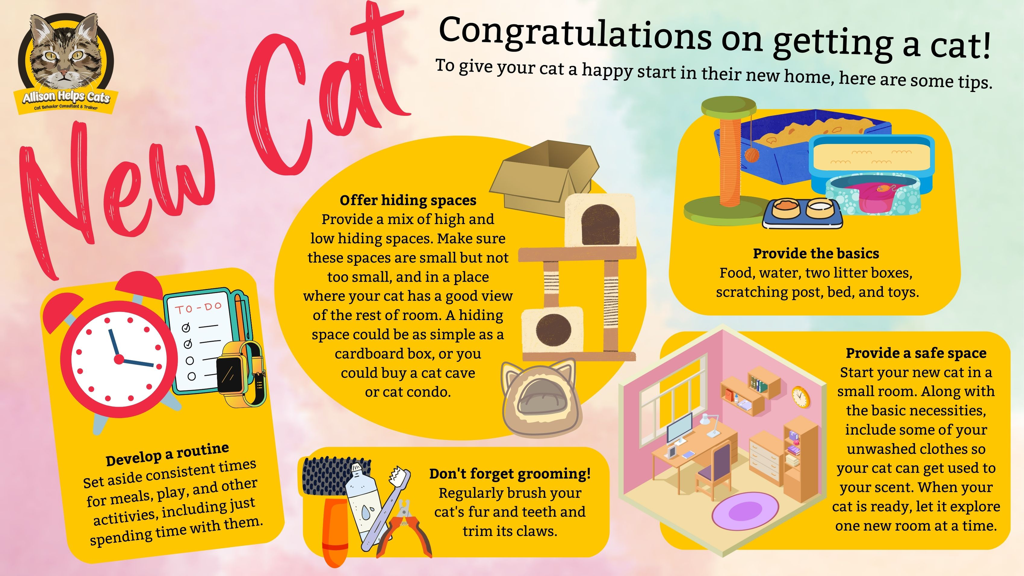
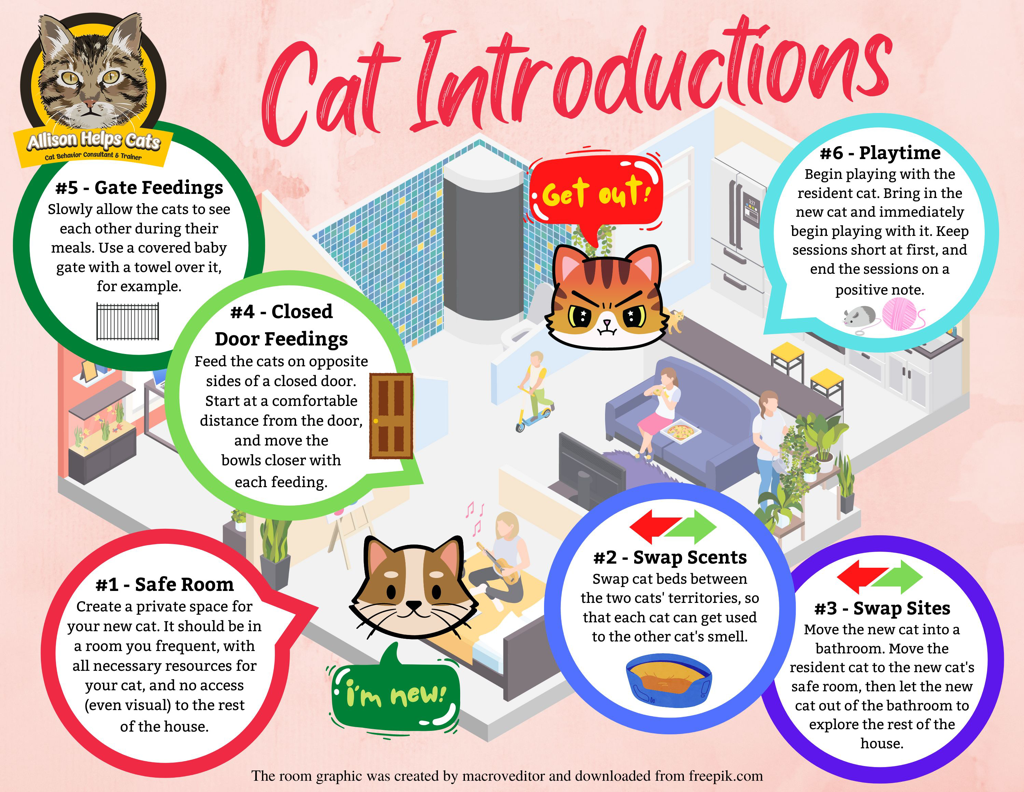
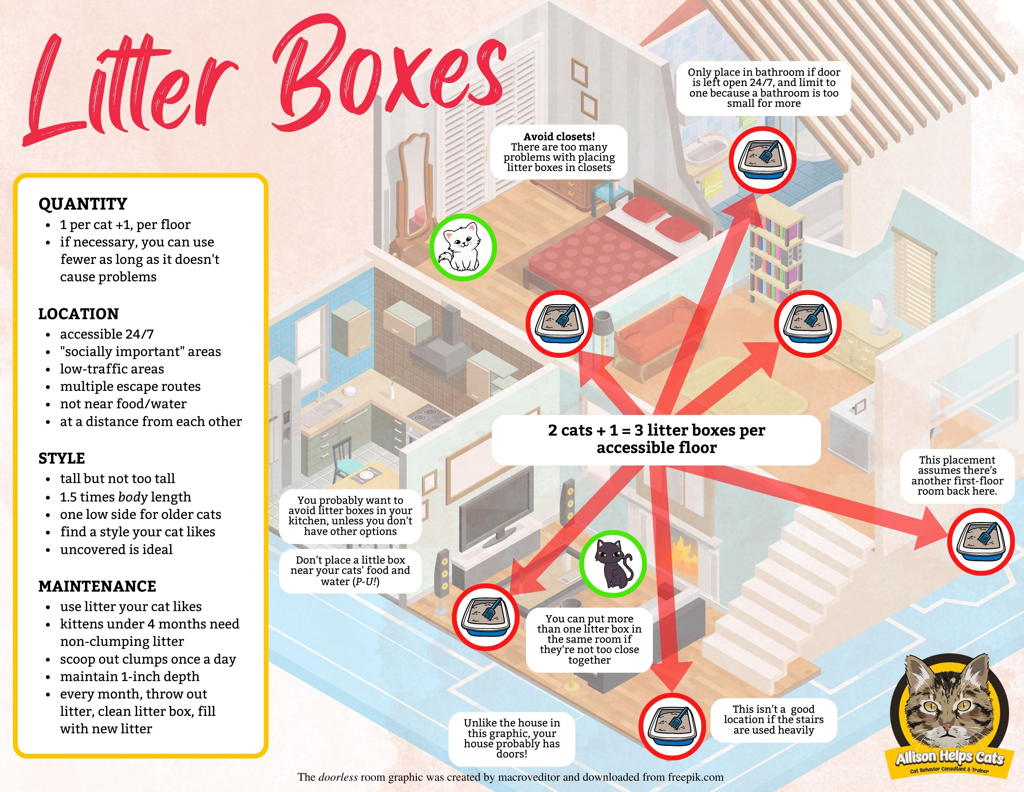
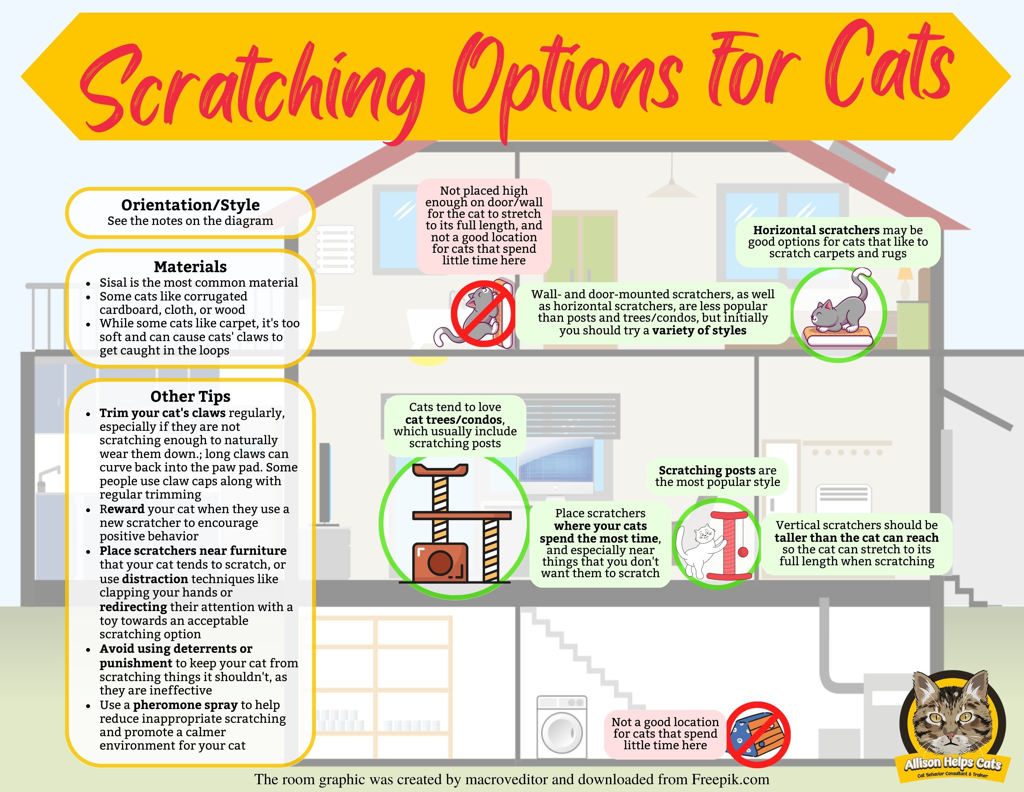
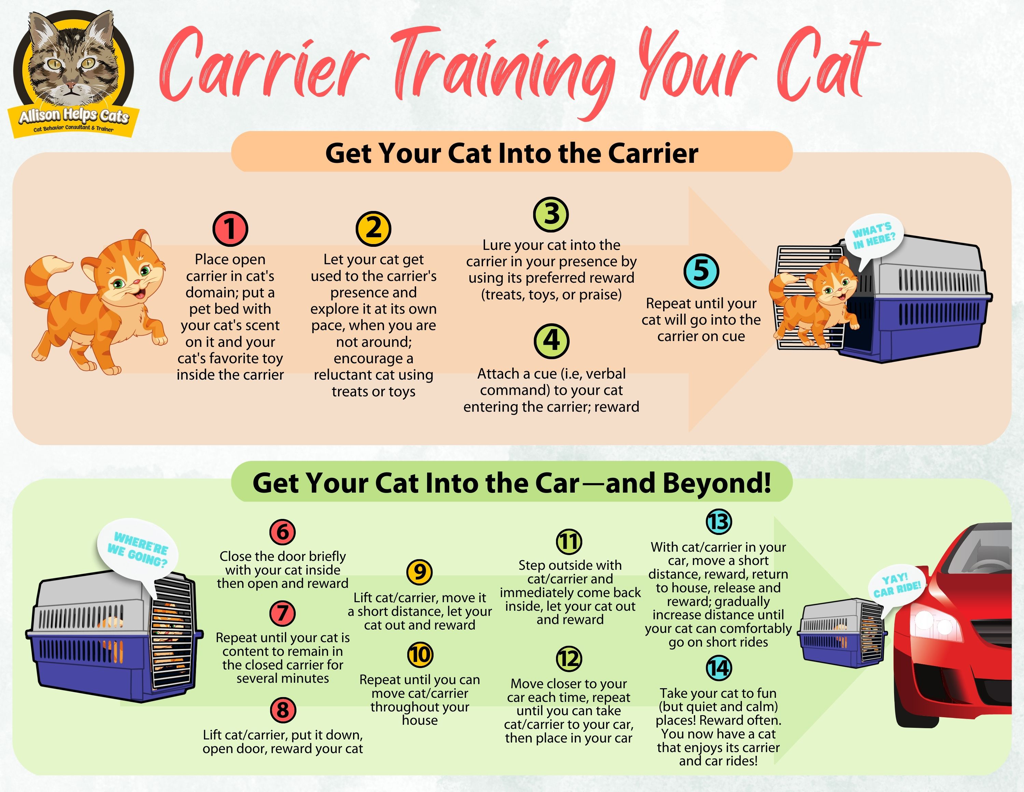
 Donate
Donate